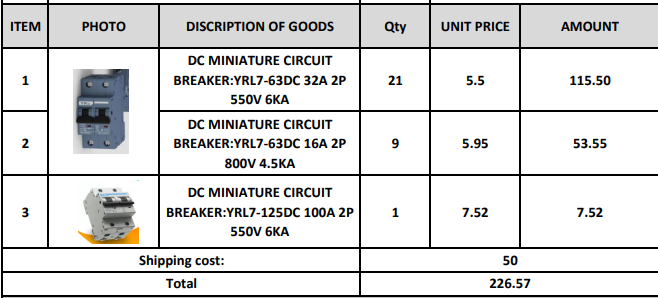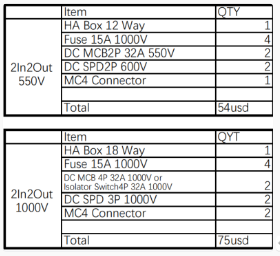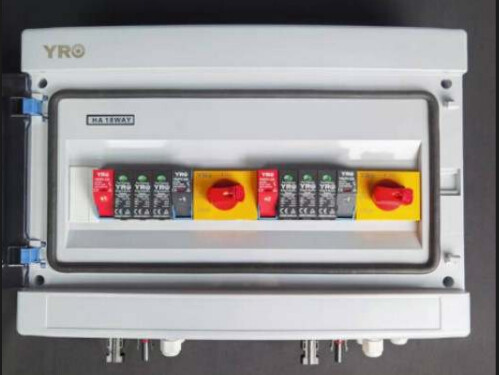Fuses and breakers are both horribly inaccurate devices with wide variability in trip time and trip current.
You are playing Russian Roulette as to which one will trip first.
Fuses and breakers are both horribly inaccurate devices with wide variability in trip time and trip current.
You are playing Russian Roulette as to which one will trip first.
Does it matter? If a problem happens, one of the two, or both, must stop a fire from starting.
Nuisance tripping is a whole new ballgame. IF that happens … will deal with that then.
Electrical data for each string at STC:
Imp = 10.34A
Isc = 10.9A
Vmp = 155V
Voc = 189V
There are 5 strings in parallel, so if one of the strings were to become a short then the reverse fault current could be anything up to 44A.
The breakers are 16A and fuses are 15A.
You are still playing a game of ‘what if’.
IIRC for common classes of fuses and breakers, the spec is ‘trip within 120s at 2x rated current’.
So, at 32A you have a potential (but unlikely) 120s window in which the breaker can ark.
You also have a far less likely window at 16A, where the spec is something like ‘will NOT trip within 600s at rated current’. So any time after 10 minutes at 16A you are in no-man’s land.
Or what if the ark has a high enough voltage drop to drop the current below the fuse rating?
Dozens of unknowns. All unlikely - but if you hit one, you have trouble.
Personally, I would remove the breakers and install fuses. If you have to test a single string, turn off the isolator, open the fuse and turn on the isolator.
You are introducing a hell of a lot of what-ifs just to be able to turn off a single string under load.
Respectfully, not playing Russian roulette nor a game of “what if” … reading and asking questions, trying to understand.
For as I said, thinking of putting the fuses between the panels and the breakers … similar to Andre, as Mark also alluded to.
If there is a problem upstream the fuses will deal with that reverse current protecting the wire, EXACTLY the same as if there were no breakers installed at all.
So with that in mind, what further complications are there with the breakers downstream from the fuses if one wants to leave them there, they function as an isolator per string?
Bit of a waste to just chuck them … unless there is a good reason to do so.
Justin has pointed out a good point… The MCB doesn’t trip correctly but arks… before the fuse under reverse current. Not good. Better no breaker just fuse.
Or you can pass one leg of the PV in the right direction and then in the wrong direction through the double-pole MCB. (or something equivalent).
( You want to achieve that whatever the current direction, one pole of the MCB is correct to break the arc by changing the wiring so that there is a pole catering for both current directions).
Just remember to consider the voltage rating of the MCB, which will be halved, as only one contact will be doing the breaking work.
I’d imagine this would wreak havoc with most people’s OCD, but I’m an engineer, not a psychologist. But as I alluded to earlier in this thread, you’ll fool someone who comes after you who will unknowingly change things back to the convention. So, it’s probably only recommended for a stop-gap condition.
I sketched a number of scenarios above where the breaker can trip (and start an ark) before the fuse pops.
If you want to guarantee that the fuse goes first, you need to get full data sheets for both fuse and breaker, and make sure their characteristic windows don’t overlap. I am guessing the breaker needs to be at least double the fuse rating.
This thread could not have come at a better time. My system is getting upgraded with more PV, and bigger inverter in 3 weeks.
I have the Noark breakers ready and tested for the magnet and they have it. Also has the JX after the serial number. So no good. Ai tog.
I like the idea of being able to isolate the individual strings for testing (also under load), but I wouldn’t want the risks as indicated by Justin with this reverse current thingy. And the fuses I have clearly says don’t open under load.
My setup partially is (as TTT wants to do) - fuses after the panels and then cable onwards to the breakers.
So just to make sure, if I get proper bi - directional Noark breakers with the serial no.Ex 9BP, then I should be ok and reverse current shorts should be sorted?
Another option might be an DC Isolator switch - Max 1000V DC and 100A @ R230.00
That doesn’t look to bad at R200 per string. How will these be better than the breakers in preventing arcs under load?
Not sure, but there are also DC non directional din rail mount circuit breaker models available.
Just no info on their actual quality, which may or may not be any good.
Hopefully someone will have some experience with these.
And there the penny drops!!!
Gotcha! The devil is in the detail.
Right, I’m getting the Ex9BP 16a NoArk breakers.
The cost of new fuse holders and fuses (+ spares) and a new isolator vs. just replacing the 4 NoArks in this Combiner Box, is not the end of the world.
But before I do it … by using the right Ex9BP, designed for PV, Non-Polarized AND it must have no magnetic potential … any other concerns, “don’t do it!”?
Will this now be the correct breaker for handling all potential problems in the Combiner Box?

Also eagerly waiting for confirmation. I need to do this as well.
I hsve never used them, but they hsve the correct specifications for the job.
For anyone who is inclined to buy on Alibaba (with slow freight shipping).
You can save a bit. It was over a year ago, but I don’t think you can beat these prices.
I can vouch that these MCBs are non-directional, as I have actually proven them with bi-directional current injection.
(I have the kit to do that).

The company is:
Yueqing Yirui Electric Appliance Co., Ltd
Ask for : Christina Chen
No affiliation, however good experiences with several purchases.
Which reminds me, I ended up buying entire pre-made combiner boxes for my intended PV inverters:
There were various combiner box configurations.
Here are some quotes I received at the time
I went with the 1000V version of 2 strings in 2 strings for my higher voltage PV inverters at 75usd each.


I thought these were outstanding value. They are variations on the pic below. I couldn’t really see the worth of building it myself at those prices:

They also do high current MCCBs at the best prices I could find.
My “advisor” agrees, they meet the requirements, and he will sign off.
I’m going NoArk.
@justinschoeman , just want to say again, thank you for this heads-up!
Really appreciated man.
Respect.
We’ve all learned a ton here … my new “Monkey See Monkey Do”, has a new “picture”.
Yeah. Some things are a lot trickier than they seem.
As I noted earlier, Australia decided that the only safe way to use DC circuit breakers on PV was to ban them entirely. It is something that is easy even for professionals to get wrong. DIYers are almost certain to make some mistakes along the way.
Am I misunderstanding a basic issue ? As I understand it, a panel has a short-circuit current Isc (typically 10A to 19A depending on the panel). This is the current that will flow if you short the leads under full sunlight. I have assumed that this is also true when you have several panels in series in a string. If you have a 20A fuse in circuit, I cannot see under what circumstances this fuse would blow. Are we assuming that a string of panels which can produce 15A when under full intense sunlight would somehow suddenly produce more than 20A ? If you have a short in the home run wiring of 1 string between the roof and the DC combiner box, the current will not pass through the fuse anyway. I am not saying this is not dangerous, but the fuse or breaker will not help. I guess one could visualise a scenario where 2 red wires and the corresponding 2 black wires could short thus connecting 2 strings in parallel while still feeding the MPPT - I guess this would cause the fuse to blow.
Help me out - am I missing something ?